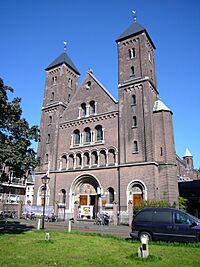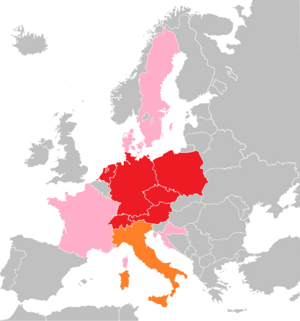Union of Utrecht (Old Catholic) facts for kids
Quick facts for kids Union of Utrecht of the Old Catholic Churches |
|
|---|---|
| Utrecher Union der Altkatholischen Kirchen | |

St. Gertrude's Cathedral is the mother church of the Union, located in Utrecht, Netherlands.
|
|
| Abbreviation | UU |
| Classification | Old Catholic |
| Governance | Episcopal |
| Metropolitan of Utrecht | Bernd Wallet |
| Associations | World Council of Churches |
| Full Communion | Anglican Communion Church of Sweden Philippine Independent Church Mar Thoma Syrian Church |
| Region | Europe |
| Headquarters | Utrecht, Netherlands |
| Origin | 1889 Utrecht, Netherlands |
| Separated from | Roman Catholic Church |
| Separations | Union of Scranton Old Roman Catholic Churches |
| Members | c. 58,806 |
The Union of Utrecht of the Old Catholic Churches, often called the Union of Utrecht (UU), is a group of Old Catholic churches. These churches are organized in different countries. They formed after disagreeing with some new teachings from the Roman Catholic Church in 1870. The churches in the Union of Utrecht are not connected to the Roman Catholic Church.
The Declaration of Utrecht from 1889 is a key document for the Union. Many churches in the Union of Utrecht are part of the World Council of Churches. The Union of Utrecht also has special partnerships, called "full communion," with other Christian groups. These include the Evangelical Lutheran Church of Sweden and the Anglican Communion. They also have partnerships with the Philippine Independent Church and the Mar Thoma Syrian Church.
As of 2016, the Union of Utrecht included six main member churches. These are the Old Catholic Church of the Netherlands, the Catholic Diocese of the Old Catholics in Germany, and the Christian Catholic Church of Switzerland. Other members are the Old Catholic Church of Austria, the Old Catholic Church of the Czech Republic, and the Polish Catholic Church in Poland. In 1992, the Union had about 400,000 members. However, by 2016, the number of members was estimated to be around 58,806.
Contents
A Brief History of the Union
How the Union Started
The first church in this group, the Old Catholic Church of the Netherlands, began in the 1700s. This happened because of disagreements between local church leaders and the main Roman Catholic leadership. Other churches, like those in Germany and Switzerland, joined later. They formed their own groups after the First Vatican Council. This council introduced the idea of papal infallibility, which means the Pope cannot be wrong on certain matters of faith.
Challenges and Changes
Over time, the Union of Utrecht tried to spread its message to new areas. For example, in the former Yugoslavia, there were Old Catholic churches established in the 1920s. However, these churches eventually faced difficulties and stopped existing as separate groups. Remaining Old Catholic communities in that region later came under the care of the Old Catholic Church of Austria.
The Polish National Catholic Church in the United States was once a member of the Union of Utrecht. However, by 1997, there were disagreements between this church and other Union members. These disagreements led to the Polish National Catholic Church leaving the Union in 2003. They then formed their own group called the Union of Scranton in 2008.
The Old Catholic Church of Slovakia was a member from 2000 but was removed in 2004. In 2011, the Christian Catholic Church of Switzerland stopped its special support for Old Catholic groups in Italy. These groups were then offered help by other churches to continue their activities.
How the Union is Organized
The churches that are part of the Union of Utrecht have a lot of freedom. This is similar to how the Anglican Communion works. Each main church has its own leader, called a bishop. In countries with more than one church area, one bishop is chosen to be in charge.
The main leader of the entire Union is the Archbishop of Utrecht. This leader is seen as the "first among equals" among all the bishops. From 2000 to 2020, Joris Vercammen was the Archbishop. In 2020, Bernd Wallet became the new Archbishop.
Beliefs and Practices
Old Catholic churches have some key beliefs that set them apart. They do not believe the Pope has power over all churches. They also do not agree with the idea of papal infallibility, which was defined in 1870. This teaching states that the Pope cannot make mistakes on certain religious matters. They also do not agree with the Roman Catholic teaching of the Assumption of Mary (1950).
Old Catholics believe that Jesus is truly present in the Eucharist, which is a special church service. However, they do not insist on one specific way to explain how this happens. They generally do not use certain phrases in the Nicene Creed, a statement of Christian belief. They also do not have a strict teaching about Purgatory, which is a place of purification after death. However, they do believe that God's grace can purify people after death, and they pray for those who have passed away.
They follow many traditional Western Christian practices. For example, they perform baptism by pouring water. They also use unleavened bread in the Eucharist. Old Catholic churches share many similarities with Orthodox, Lutheran, and Anglican churches. For instance, their priests can choose whether or not to marry. The churches in the Union of Utrecht accept the core teachings of the Christian Church from before the Great Schism in 1054 AD.
See also
 In Spanish: Unión de Utrecht (Iglesias) para niños
In Spanish: Unión de Utrecht (Iglesias) para niños
- Willibrord Society


